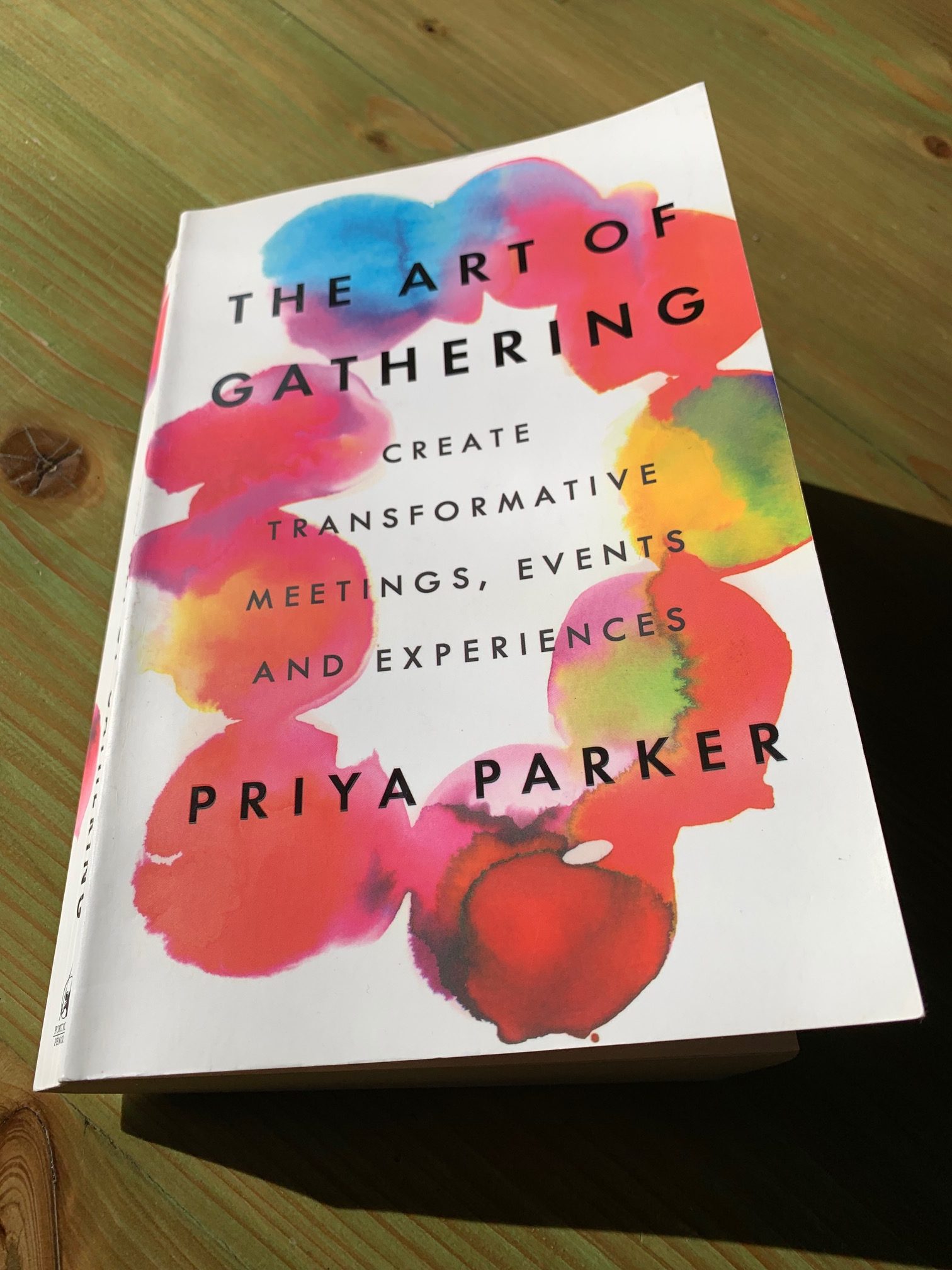For a while I’ve had this book sitting on my ever-growing ‘to read’ pile, and earlier this week I finally picked it up and – my goodness – am I glad I did!
In the way I recommend Nancy’s Kline’s ‘Time to Think’ as the most inspiring, simple and practical read for those wanting to understand coaching; ‘The Art of Gathering’ has that status of ‘if you read one book about…’ for facilitators or people organising public events.
Priya Parker’s book is a deceptively simple set of principles about how to create effective meetings or ‘gatherings’. It’s the kind of simple I like: a master practitioner takes a complex topic and breaks it down into the core principles – richly illustrated with great examples. These principles apply as much to work meetings or conferences as they do to artistic and public events, or social and family gatherings. Proving this point, Parker’s book draws on examples ranging from high level diplomatic conferences, to social events, theatre performances and stag dos.
I’d highly recommend reading the entire book itself. It only took me two long train journeys (about 6 hours) to read cover to cover; so there’s no excuse not to read the original. But to whet your appetite here is a quick précis of the headlines– set out under some of the key pieces of advice which each form a chapter:
Decide why you’re really gathering
The first question we need to answer when designing a meeting or event is why? What do you hope to achieve? Why are you meeting now? What’s your purpose – what do you want to be different as a result of the meeting/ event? Is it about making decisions, generating ideas, creating better trust between people?
The answer to this question needs to be as specific and as exciting as possible. Ideally we need to start with an ExACT coaching-style goal – so help yourself to my ExACT worksheet folks, if that’s helpful.
The clearer and more compelling the answer – the better.
In a later chapter Parker drills deeper into creating compelling events (‘Cause good controversy’) with tips about how best to surface the conversations that need to happen. The bottom-line is this takes time before an event. This reminds me we need to resource that preparation and make time for it, rather than expecting the magic to happen just on the day itself. I think clients and facilitators alike can underestimate this.
And as Parker says a meeting ‘category’ – such as Board awayday, team meeting, networking event – is not a purpose. You need to dig deeper – what’s the desired outcome of that Board awayday? Keep asking why until you get to the heart of the matter.
Purpose must come first and inform every decision about form that follows.
Close doors
If you say you’re for ‘everyone’ or ‘anyone’ there is a serious risk you’re end up serving no-one well. Being clear about who needs to be involved, or who and event is for, means deciding who it is not for, including who might inhibit others or get in the way.
Practically, there are limits to how many people can be involved in conversations. Parker suggests this is around 12-15, and fewer still for difficult conversations or decision-making.
‘Closing the doors’ is also about creating boundaries – making a space feel safe so that we can be honest, take risks etc.
I’m going to quote from her directly here because I found what she says about defining who the event is for deeply resonated with some of the conversations I witness around purpose and audience strategy in cultural organisations:
‘… when you don’t root your gathering up front in a clear, agreed-on purpose, you are often forced to do so belatedly by questions of membership that often arise. This is what happened in [EXAMPLE] We didn’t think about what it was for until we found ourselves in an argument about who it was for. To be clear, I don’t recommend backing into purpose through the question of whom to invite. But the link between the two issues illustrates that the purpose of the gathering can remain somewhat vague and abstract until it is clarified by drawing the boundary about who is in and out. When you exclude, the rubber of purpose hits the road.’
Time and again I see cultural organisations internally debating the ‘who’. What this quote highlights for me is that this is really an indicator that there’s confusion around purpose that’s showing up when we get to the question of the guest list….
The other critical question about metaphorical ‘doors’ is location or venue. When I’m invited in to facilitate a venue has already been chosen, often on grounds of convenience or cost, and I find myself trying to salvage a way to make the space work for the purpose of the event, rather than hindering it.
Logistics and cost need to be considered, but choice of space can be a powerful enabler of a successful meeting or event. The venue should align with and enable the purpose – for example, if you want people to think differently and work in new ways that less likely to happen if you call them in to meet around the table they normally sit around for day-to-day business….
Don’t be a chill host
As the host – the person responsible for bring people together – you have power and responsibility. What are those responsibilities? Parker suggests a good host will:
- Connect guests or participants with one another
- Equalize guests or participants
- Protect your guests (including, from one another – imagine the garrulous Uncle pinning someone in the corner at a family wedding with his dull anecdotes)
Parker notes hosts sometimes abdicate that power through a mis-placed sense of modesty. But when we abdicate our power as hosts you don’t eradicate power – we create a vacuum that causes anxiety and confusion, or worst still allows someone else to take that power and that rarely serves the whole group. Instead a host needs to be comfortable with ‘generous authority’: the strong, confident hand that imposes rules on behalf of others.
Create a temporary alternative world
This chapter is full of fantastic examples of how temporary rules for a meeting or event can encourage different behaviours. Inviting playful and imaginative behaviour can create memorable and useful meetings and events, although it is important participants know what to expect before they arrive. Therefore, part of the role of the invitation is to prime the guests so they understand what they’re signing up to by coming along.
There’s a whole chapter about how we can encourage the authenticity needed to have productive conversations (‘Keep your best self out of my gathering’) packed with various examples ways to enable this.
The other very helpful distinction Parker makes in this section is about assumed and explicit norms of behaviour. When we don’t make our expectations about how to behave in a group explicit we are excluding others, especially those who might have different background of experience to the majority. By contrast when we spell out (and agree) how we want to behave then we enable equal participation.
Never start a funeral with logistics (and Accept that there is an end)
The start and end have more impact than any other part of a meeting or event. Yet Parker notices how often we miss an opportunity to set the tone or engage participants by starting with a logistics announcement (‘before we start, in the event of a fire….’ Or ‘We would like to thank our sponsors…’). Why not start with a bang?
She also reminds us that an event actually starts the minute participants hear of it – usually some time before they arrive in the room. It starts when the meeting request email is received for a team building event or the papers are sent out for a Board meeting.
The mindset or mood in which participants arrive has a huge impact – for good or ill – on the event. Yes, a skilled facilitator can warm things up, but this then takes time which eats into the meeting or event; how much better people arrive ready and excited to contribute?
Therefore Parker advises us not to miss that opportunity to ‘prime’ the participants, suggesting 90% of what makes a great event is put in place beforehand. This can be a simple ‘pre-game’ such as answering a few questions in advance or bringing along a small object as a talking point linked to the theme of the day. For events with high stakes or a need to shift the prevailing dynamic then Parker often uses a structured pre-event dinner designed to connect participants as people and enable them to be vulnerable and honest with one another.
There are some brilliant examples in this section about how to prime and start events with a swing from naming, pre-games and use of metaphorical passageways.
Similarly she advises not to allow events to fizzle out – clear structured ending that allow processing of what has happened and preparation for follow-up after the event need to be carefully planned.
What I love about this book is that it has helped me understand better what enables some events or meetings to really connect and reminded me of some pitfalls to avoid as a facilitator. It also provides examples of some very creative and simple formats or activities that can be used in a variety of contexts for meetings and events.

